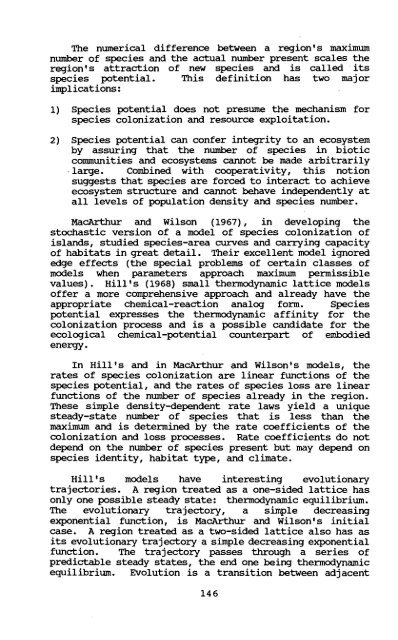THE GREAT LAKES
THE GREAT LAKES
THE GREAT LAKES
Create successful ePaper yourself
Turn your PDF publications into a flip-book with our unique Google optimized e-Paper software.
The numerical difference between a region's maximum<br />
number of species and the actual number present scales the<br />
region's attraction of new species and is called its<br />
species potential. This definition has two major<br />
implications:<br />
1) Species potential does not presume the mechanism for<br />
species colonization and resource exploitation.<br />
2) Species potential can confer integrity to an ecosystem<br />
by assuring that the number of species in biotic<br />
communities and ecosystems cannot be made arbitrarily<br />
large. Combined with cooperativity, this notion<br />
suggests that species are forced to interact to achieve<br />
ecosystem structure and cannot behave independently at<br />
all levels of population density and species number.<br />
MacArthur and Wilson<br />
(1967), in developing the<br />
stochastic version of a model of species colonization of<br />
islands, studied species-area curves and carrying capacity<br />
of habitats in great detail. Their excellent model ignored<br />
edge effects (the special problems of certain classes of<br />
models when parameters approach maximum permissible<br />
values) . Hill ' s (1968) small thermodynamic lattice models<br />
offer a more comprehensive approach and already have the<br />
appropriate chemical-reaction analog form. Species<br />
potential expresses the thermodynamic affinity for the<br />
colonization process and is a possible candidate for the<br />
ecological chemical-potential counterpart of embodied<br />
energy.<br />
In Hill's and in MacArthur and Wilson's models, the<br />
rates of species colonization are linear functions of the<br />
species potential, and the rates of species loss are linear<br />
functions of the number of species already in the region.<br />
These simple density-dependent rate laws yield a unique<br />
steady-state number of species that is less than the<br />
maximum and is determined by the rate coefficients of the<br />
colonization and loss processes. Rate coefficients do not<br />
depend on the number of species present but may depend on<br />
species identity, habitat type, and climate.<br />
Hill's models have interesting evolutionary<br />
trajectories. A region treated as a one-sided lattice has<br />
only one possible steady state: thermodynamic equilibrium.<br />
The evolutionary trajectory, a simple decreasing<br />
exponential function, is MacArthur and Wilson's initial<br />
case. A region treated as a two-sided lattice also has as<br />
its evolutionary trajectory a simple decreasing exponential<br />
function. The trajectory passes through a series of<br />
predictable steady states, the end one being thermodynamic<br />
equilibrium. Evolution is a transition between adjacent

















